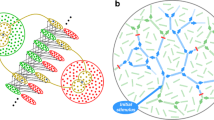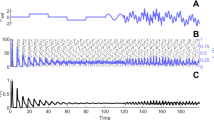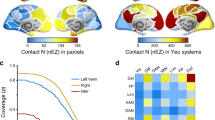Abstract
Experimental results suggest that neurons in the cortex synchronize their action potentials on the millisecond time scale. More importantly this binding expresses functional relationships between the neurons. A model of neuronal interactions is proposed in which simultaneous discharges of neurons develop through specialized synaptic circuits. As an important prerequisite for this synchronization it is demonstrated that SynFire chains, generating different levels of excitation, propagate their activity waves at distinct velocities. Two chains were coupled by excitatory synapses and their activity was initiated at different times. Due to synaptic interactions, activity in the earlier-initiated chain accelerates propagation in the other chain until the two activity waves are synchronized. Compared with several neural network models with oscillatory units, physiologically more plausible neurons are simulated. It is still under debate whether neurons in the cortex show oscillatory dischargesper se. In particular, a high rate of noise relative to very weak synaptic gains cannot impair our results in the neural network simulations.
Similar content being viewed by others
References
Abeles M (1982) Local cortical circuits: an electrophysiological study. Springer, Berlin Heidelberg New York
Abeles M (1991) Corticonics: neural circuits of the cerebral cortex. Cambridge University Press, Cambridge
Abeles M, Prut Y, Bergman H, Vaadia E, Aertsen AMHJ (1993) Integration, synchronicity, and periodicity. In: Aertsen A (ed) Brain theory. Elsevier, Amsterdam
Aertsen AMHJ, Gerstein GL, Habib MK, Palm G (1989) Dynamics of neuronal firing correlation: modulation of ‘effective connectivity’. J Neurophysiol 61:900–917
Agmon-Snir H, Segev I (1993) Signal delay and input synchronization in passive dendritic structures. J Neurophysiol 70:2066–2085
Bienenstock E (1991) Notes on the growth of a ‘composition machine’. In: Contributions to interdisciplinary workshop on compositionality in cognition and neural models, Asières sur Oise, France. Abbaye de Royaumont Publ. 1–19
Bienenstock E (1995) A model of neocortex. Network 6:179–224
Chen D-F, Fetz EE (1993) Effect of synchronous neural activity on synaptic transmission in primate cortex. Soc Neurosci Abstr 19:(319.7)
Douglas RJ, Martin KAC (1991) An intracellular analysis of the visual responses of neurons in cat visual cortex. J Physiol (Lond) 440:659–696
Eckhorn R, Bauer R, Jordan W, Brosch M, Kruse W, Munk M, Reitboeck HJ (1988) Coherent oscillations: a mechanism of feature linking in the visual cortex? Multiple electrode and correlation analysis in the cat. Biol Cybern 60:121–130
Eder K, Geiger H, Brauer W (1993) A neurophysiologically motivated neural network model and its application to the superposition problem. In: Proceedings ICANN'93 Springer, Berlin Heidelberg New York, pp 482–485
Gray CM, Singer W (1987) Stimulus-specific neuronal oscillations in the cat visual cortex: a cortical functional unit. Soc Neurosci Abstr 13:(404.3)
Gray CM, Singer W (1989) Stimulus-specific neuronal oscillations in orientation columns of cat. Proc Natl Acad Sci USA 86:1698–1702
Griffith JS (1963) On the stability of brain like structures. Biophys J 3:229–308
Hebb DO (1949) The organization of behavior. Wiley, New York
Kandel ER, Schwartz JH, Jessell TM (1991) Principles of neural sciences, 3rd edn. Elsevier, Amsterdam
Knight B (1972) Dynamics of encoding in a population of neurons. J Gen Physiol 59:734–766
Malsburg C von der (1981) The correlation theory of brain function. (Internal report 81-2) Max Planck Institute for Biophysical Chemistry, Göttingen
Roelfsema PR, König P, Engel AK, Sireteanu R, Singer W (1994) Reduced synchronization in the visual cortex of cats with strabismic amblyopia. Eur J Neurosci 6:1645–1655
Shadlen MN, Newsome WT (1994) Noise, neural codes and cortical organization. Curr Opin Neurobiol 4:569–579
Stein RB (1967) The frequency of nerve action potentials generated by applied currents. Proc R Soc B Lond 167:64–86
Stelzer A, Simon G, Kovacs G, Rabindra R (1994) Synaptic disinhibition during maintenance of long-term potentiation in the CA1 hippocampal subfield. Proc Natl Acad Sci USA 91:3058–3062
Stuart GJ, Sakmann B (1994) Active propagation of somatic action potentials into neocortical pyramidal cell dendrites. Nature 367:69–72
Vaadia E, Haalman M, Abeles M, Bergman H, Prut Y, Slovin H, Aertsen AMHJ (1995) Dynamics of neuronal interactions in monkey cortex in relation to behavioral events. Nature 373:515–518
Author information
Authors and Affiliations
Rights and permissions
About this article
Cite this article
Arnoldi, HM.R., Brauer, W. Synchronization without oscillatory neurons. Biol. Cybern. 74, 209–223 (1996). https://doi.org/10.1007/BF00652222
Received:
Accepted:
Issue Date:
DOI: https://doi.org/10.1007/BF00652222




